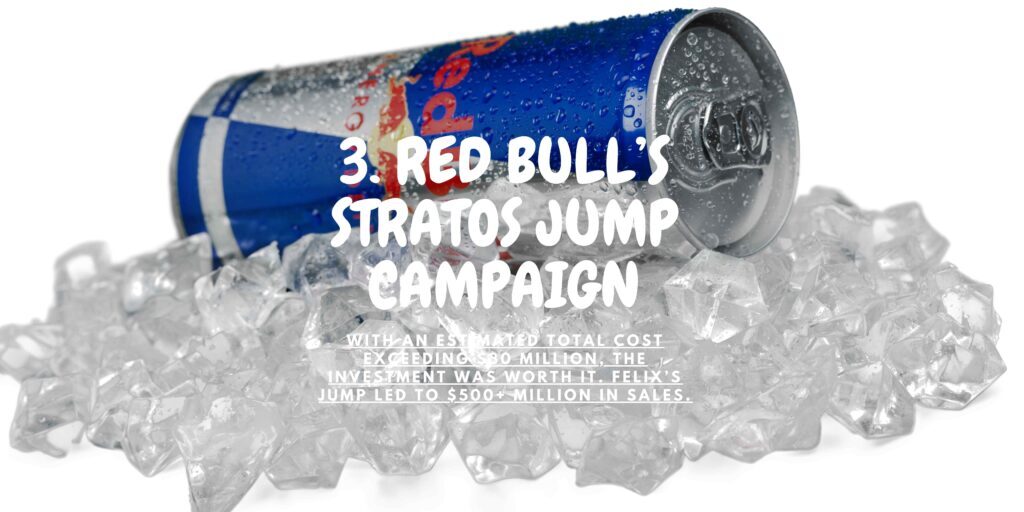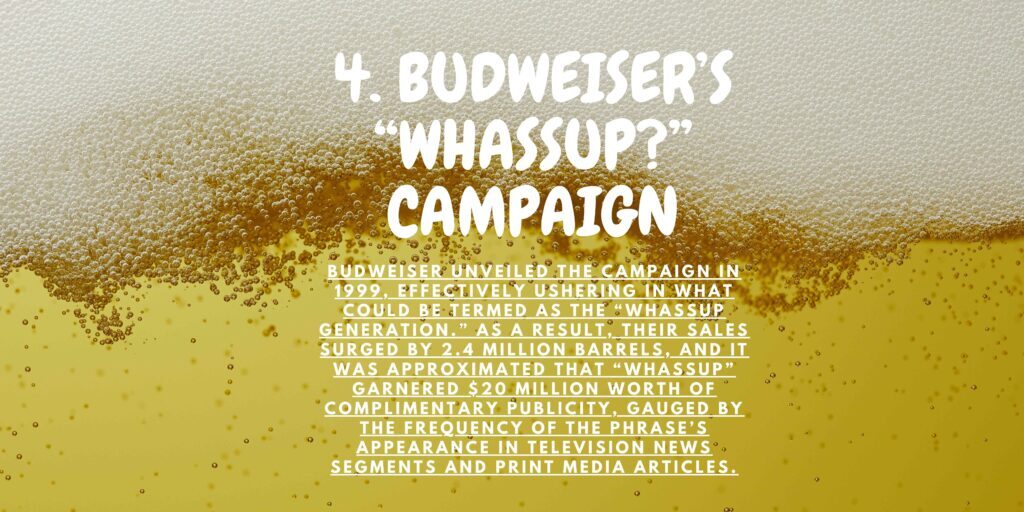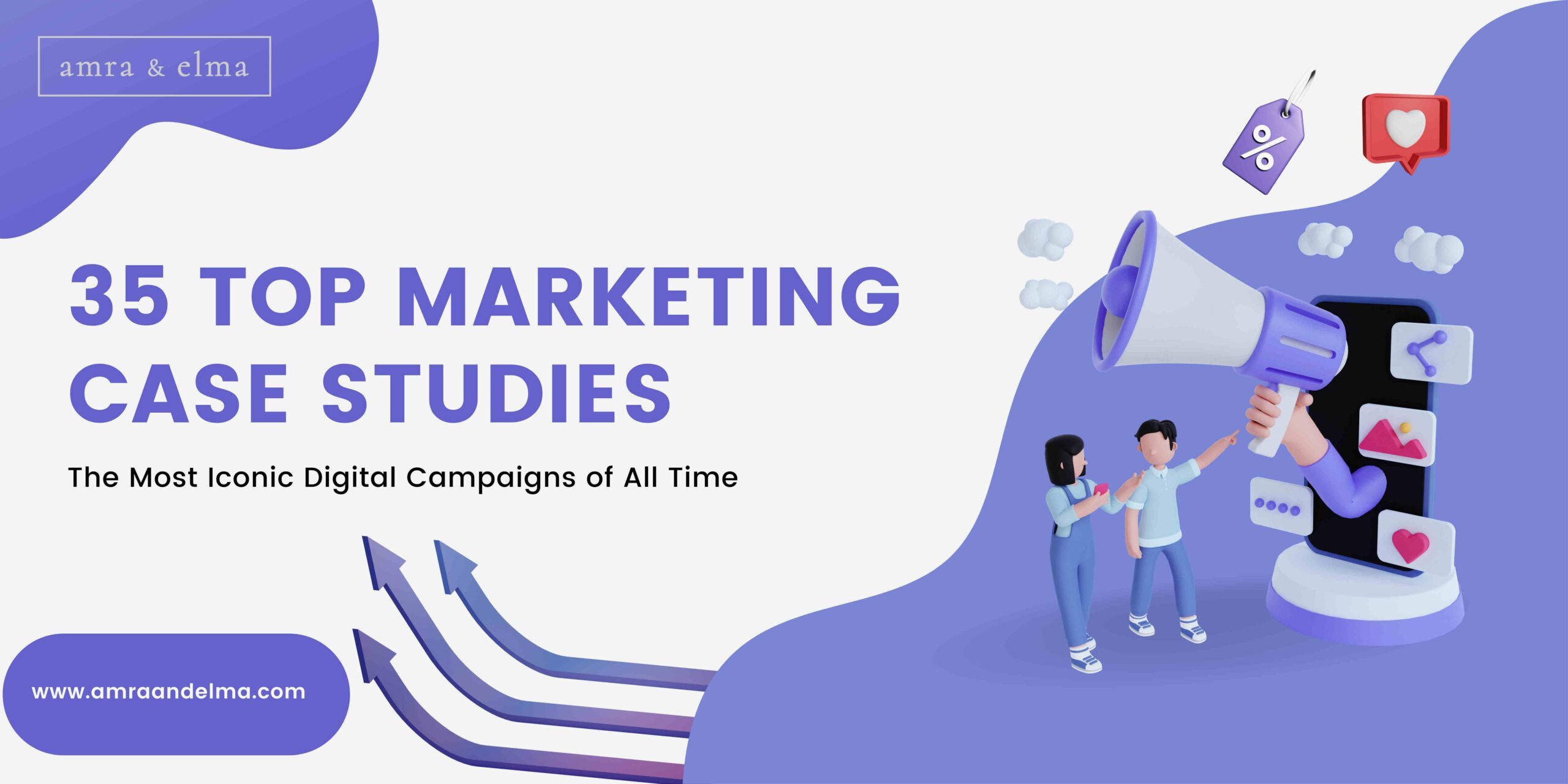
02 Apr 35 TOP MARKETING CASE STUDIES
In the dynamic world of marketing, success often hinges on innovation, creativity, and strategic thinking. While theories and concepts provide a foundation, it’s the real-world applications and success stories that truly inspire and inform marketers around the globe. Marketing case studies offer invaluable insights into the strategies, tactics, and campaigns that have propelled brands to new heights, showcasing the power of creativity, data-driven decision-making, and consumer-centric approaches.
From iconic brand revitalizations to groundbreaking digital campaigns, marketing case studies provide a window into the minds of industry leaders and innovators. These stories not only celebrate achievements but also offer valuable lessons and inspiration for marketers seeking to navigate the ever-evolving landscape of consumer behavior, technology, and competition.
In this comprehensive guide, we delve into 35 top marketing case studies from various industries and sectors. Each case study highlights the exceptional strategies, tactics, and executions that set them apart and contributed to their success. From timeless classics to modern-day triumphs, these case studies offer a roadmap for marketers looking to make their mark and drive results in an increasingly competitive marketplace.
Join us as we explore the stories behind some of the most iconic and influential marketing case studies of all time. From Coca-Cola’s innovative storytelling to Airbnb’s disruptive brand building, these case studies exemplify the ingenuity, adaptability, and creativity that define exceptional marketing in the 21st century.
Get ready to be inspired, informed, and empowered as we uncover the secrets behind the success of these 35 top marketing case studies. Whether you’re a seasoned marketer seeking fresh ideas or a budding enthusiast eager to learn, this journey promises to be enlightening and enriching. So, without further ado, let’s dive into the world of marketing excellence and discover what makes these case studies truly exceptional.
35 Top Marketing Case Studies and What Makes Them Exceptional
1. BEN & JERRY’S “PINT SLICE SOCIAL” MARKETING CASE STUDY
2. BLENDECT’S “WILL IT BLEND?” MARKETING CASE STUDY
3. RED BULL’s STRATOS JUMP MARKETING CASE STUDY
4. BUDWEISER’S “WHASSUP?” MARKETING CASE STUDY
5. OLD SPICE’S “THE MAN YOUR MAN COULD SMELL LIKE” MARKETING CASE STUDY
6. PEPSI: “IS PEPSI OK?” MARKETING CASE STUDY
7. APPLE’S “THINK DIFFERENT” MARKETING CASE STUDY
8. COCA COLA’S “SHARE A COKE” MARKETING CASE STUDY
9. NIKE’S “JUST DO IT” MARKETING CASE STUDY
10. APPLE’S “1984” MARKETING CASE STUDY
11. AXE’S “FIND YOUR MAGIC” MARKETING CASE STUDY
12. BURGER KING’S “RECLAIM THE FLAME” MARKETING CASE STUDY
13. GUINNESS’S “SURFER” MARKETING CASE STUDY
14. MCDONALD’S “I’M LOVIN’ IT” MARKETING CASE STUDY
15. AIRBNB’S “LIVE THERE” MARKETING CASE STUDY
16. LAY’S “DO US A FLAVOR” MARKETING CASE STUDY
17. AMAZON’S “AMAZON PRIME” MARKETING CASE STUDY
18. GOPRO’S “BE A HERO” MARKETING CASE STUDY
19. VOLVO TRUCKS’ “THE EPIC SPLIT” MARKETING CASE STUDY
20. DOVE’S “REAL BEAUTY SKETCHES” MARKETING CASE STUDY
21. SPOTIFY’S “WRAPPED” MARKETING CASE STUDY
22. ICELAND’S GROCERIES MARKETING CASE STUDY
23. HEALTH-ADE’S MARKETING CASE STUDY
24. ALWAYS’ “LIKE A GIRL” MARKETING CASE STUDY
25. COCA-COLA’S “SMALL WORLD MACHINES” MARKETING CASE STUDY
26. BURGER KING’S “WHOPPER DETOUR” MARKETING CASE STUDY
27. AMAZON’S PRIME DAY MARKETING CASE STUDY
28. MCDONALD’S “OUR FOOD, YOUR QUESTIONS” MARKETING CASE STUDY
29. AIRBNB’S “EXPERIENCES” LAUNCH MARKETING CASE STUDY
30. PIZZA HUT’S “HUT REWARDS” LOYALTY PROGRAM MARKETING CASE STUDY
31. BMW’S “THE ULTIMATE DRIVING MACHINE” MARKETING CASE STUDY
32. THE MOST INTEREST MAN IN THE WORLD MARKETING CASE STUDY
33. APPLE’S “GET A MAC” MARKETING CASE STUDY
34. PROCTER AND GAMBLE’S “THANK YOU, MOM” MARKETING CASE STUDY
35. METRO TRAINS “DUMB WAYS TO DIE” MARKETING CASE STUDY
What is a Marketing Case Study?
A marketing case study is a detailed examination of a specific marketing strategy, campaign, or initiative that showcases its implementation, outcomes, and impact on business objectives. It typically includes a comprehensive analysis of the target audience, market conditions, competitive landscape, marketing tactics used, and the results achieved.
In a marketing case study, key components often include the background information to set the context, such as the company’s industry, size, and goals; the challenges or opportunities that led to the marketing initiative; the strategy or approach employed, including the marketing channels, messaging, and creative elements; the execution and implementation phase; and the measurable outcomes, such as increased sales, brand awareness, customer engagement, or other relevant metrics. Additionally, a well-crafted marketing case study may also highlight lessons learned, best practices, and recommendations for future marketing efforts based on the experience and results of the case study.
What Does a Marketing Case Study Consist of?
35 Top Marketing Case Studies
1. Ben & Jerry’s “Pint Slice Social” Campaign
Ben & Jerry’s, a beloved ice cream brand known for its quirky flavors and social activism, aimed to engage its audience and drive sales of its new product, the Pint Slice, through a creative and interactive marketing campaign.
Ben & Jerry’s launched the “Pint Slice Social” campaign marketing case study, which combined social media engagement with real-world activations to generate excitement and buzz around its new product. The campaign aimed to leverage user-generated content and encourage consumers to share their experiences with the Pint Slice on social media platforms.
The “Pint Slice Social” campaign featured a series of experiential events held in various cities, where consumers could sample the new product and participate in fun activities like photo booths and ice cream-themed games. Ben & Jerry’s also encouraged consumers to share their experiences on social media using the hashtag #PintSliceSocial for a chance to win prizes and be featured on the brand’s official channels.
The marketing case study interactive and experiential elements helped Ben & Jerry’s connect with its audience on a deeper level, fostering brand loyalty and driving repeat purchases. The numbers speak for themselves:
- 100% sample redemption
- 220% increase in customer traction when compared to existing campaigns
- 68% conversion rate
What Makes it Exceptional:
Ben & Jerry’s “Pint Slice Social” campaign marketing case study is exceptional for its combination of real-world activations and social media engagement, which effectively bridged the gap between online and offline experiences. By creating opportunities for consumers to interact with the brand in person and share their experiences online, Ben & Jerry’s successfully amplified its message and generated excitement around its new product.
The PR campaign’s focus on user-generated content and community participation reinforced Ben & Jerry’s brand values of fun, inclusivity, and social activism, making it a standout example of effective marketing in the ice cream industry.

2. Blendtec’s “Will It Blend?” Campaign
Blendtec’s “Will It Blend?” campaign marketing case study emerged as a groundbreaking marketing phenomenon, showcasing the extraordinary power and durability of Blendtec blenders through a series of captivating videos. The campaign’s premise was simple yet ingenious: Blendtec founder Tom Dickson demonstrated the blender’s capabilities by blending unconventional items, ranging from iPhones to golf balls, in a series of entertaining videos.
The campaign’s impact was nothing short of extraordinary. Blendtec’s “Will It Blend?” videos quickly captured the attention of online audiences, garnering millions of views on platforms like YouTube. In fact, the videos became a viral sensation, catapulting Blendtec to internet stardom and earning them the accolade of the 33rd most-viewed series ever on YouTube.
But the success of the campaign wasn’t just limited to online views. The “Will It Blend?” videos had a tangible impact on Blendtec’s bottom line. Sales of the company’s high-end consumer blenders skyrocketed, with figures soaring by an astonishing 500% in 2008 alone. The campaign’s blend of humor, creativity, and product demonstration resonated with consumers, driving both brand awareness and sales.
What Makes it Exceptional:
Blendtec’s “Will It Blend?” marketing case study stands out as a shining example of effective content marketing and brand storytelling. By showcasing the blender’s capabilities in a fun and unconventional way, Blendtec created engaging content that captured the attention of consumers and earned widespread recognition.
Moreover, the campaign demonstrated the power of viral marketing and user-generated content. The “Will It Blend?” videos sparked conversations and sharing across social media platforms, amplifying Blendtec’s reach and attracting new customers to the brand.

3. Red Bull’s Stratos Jump Campaign
Red Bull’s Stratos Jump campaign marked a pivotal moment in extreme sports history, as Austrian skydiver Felix Baumgartner embarked on a death-defying mission to jump from the edge of space. The audacious stunt not only captivated the world but also propelled Red Bull into the stratosphere of brand recognition and solidified its reputation as a trailblazer in the realm of daring and innovation.
The campaign’s concept was as ambitious as it was awe-inspiring: Felix Baumgartner ascended to the edge of space in a helium balloon before free-falling back to Earth, breaking the sound barrier in the process. The entire event was meticulously planned and executed, with Red Bull leveraging cutting-edge technology and expert precision to ensure Baumgartner’s safety and success.
But the Stratos Jump campaign was more than just a publicity stunt; it was a masterful demonstration of brand storytelling and experiential marketing. By pushing the boundaries of human achievement and showcasing the spirit of adventure, Red Bull tapped into universal themes of courage, determination, and human potential, resonating deeply with audiences worldwide.
What Makes it Exceptional:
Red Bull’s Stratos Jump campaign stands out as a shining example of experiential marketing and brand storytelling at its finest. By orchestrating a monumental feat of human achievement and capturing it live for the world to see, Red Bull created an unforgettable moment that resonated with audiences on a visceral level.
4. Budweiser’s “Whassup?” Campaign
Budweiser’s iconic “Whassup?” campaign emerged as a cultural phenomenon in the late 1990s, capturing the essence of friendship, camaraderie, and everyday moments shared over a cold beer. The campaign, which featured a group of friends casually greeting each other with the now-famous phrase “Whassup?”, struck a chord with audiences worldwide and catapulted Budweiser to the forefront of pop culture.
At its core, the “Whassup?” campaign was a celebration of the simple joys of friendship and connection. The ads depicted relatable scenarios of friends catching up over the phone, at work, or while watching sports, punctuated by the exuberant and infectious “Whassup?” greeting. The campaign’s humor and authenticity resonated with viewers, making it an instant hit and spawning countless parodies and cultural references.
But what truly set the “Whassup?” campaign apart was its ability to transcend traditional advertising and become a cultural touchstone. The phrase “Whassup?” became a ubiquitous part of popular lexicon, with people of all ages and backgrounds adopting it as a playful greeting. From late-night talk shows to Hollywood movies, the campaign’s influence extended far beyond the realm of advertising, cementing Budweiser’s place in the zeitgeist.
The impact of the “Whassup?” campaign marketing case study on Budweiser’s brand cannot be overstated.
Budweiser unveiled the campaign in 1999, effectively ushering in what could be termed as the “Whassup Generation.” As a result, their sales surged by 2.4 million barrels, and it was approximated that “Whassup” garnered $20 million worth of complimentary publicity, gauged by the frequency of the phrase’s appearance in television news segments and print media articles.
What Makes it Exceptional:
Budweiser’s “Whassup?” campaign is exceptional for its ability to capture the spirit of a generation and become a cultural phenomenon. By embracing humor, authenticity, and the power of shared experiences, Budweiser created an advertising campaign that resonated with audiences on a deeply personal level.
5. Old Spice’s “The Man Your Man Could Smell Like” Campaign
Old Spice’s “The Man Your Man Could Smell Like” campaign revolutionized the world of men’s grooming products, captivating audiences with its humor, charm, and over-the-top masculinity. Launched in 2010, the campaign featured actor Isaiah Mustafa as the suave and confident “Old Spice Guy,” who effortlessly showcased the brand’s range of body washes and deodorants in a series of witty and memorable commercials.
At its core, the “The Man Your Man Could Smell Like” campaign was a masterclass in comedic storytelling and brand positioning. The ads humorously depicted Mustafa as the epitome of masculinity, effortlessly transitioning from one absurd scenario to the next while delivering clever and memorable lines. The campaign’s irreverent humor and tongue-in-cheek approach to advertising resonated with audiences of all ages, making it a viral sensation and earning it a permanent place in pop culture.
But the success of the “The Man Your Man Could Smell Like” campaign marketing case study extended beyond just laughs and entertainment. The campaign effectively repositioned Old Spice as a modern and relevant brand, shedding its outdated image and appealing to a new generation of consumers. By embracing humor and creativity, Old Spice differentiated itself from competitors and carved out a unique identity in the crowded men’s grooming market.
What Makes it Exceptional:
Old Spice’s “The Man Your Man Could Smell Like” campaign stands out as a prime example of how humor and creativity can elevate a brand and resonate with consumers. By embracing absurdity and pushing the boundaries of traditional advertising, Old Spice created a campaign that captured the attention and imagination of audiences worldwide.
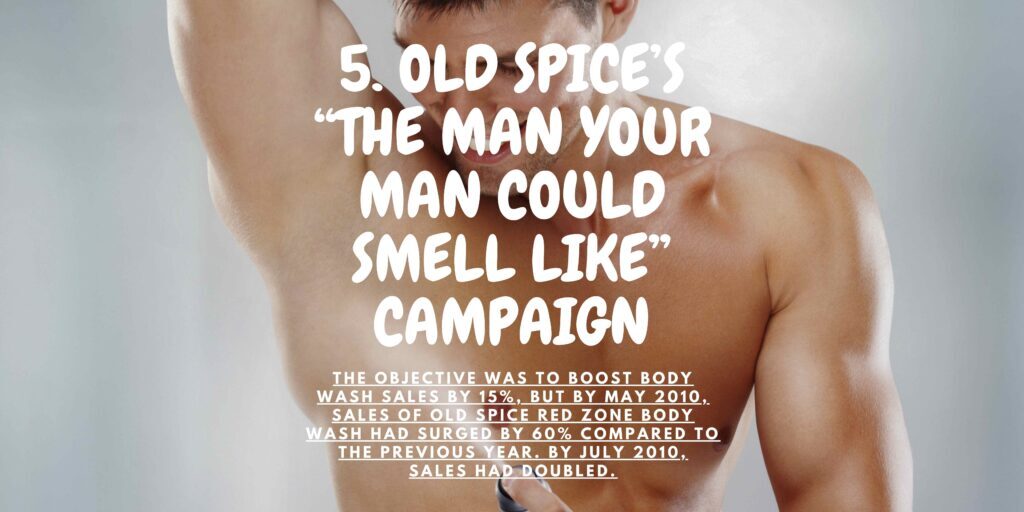
6. Pepsi: The “Is Pepsi OK?” Campaign
Pepsi’s “Is Pepsi OK?” campaign aimed to address the common question posed by consumers when offered a Pepsi instead of its rival, Coca-Cola. The campaign sought to reframe this question as a playful affirmation of Pepsi’s unique flavor and appeal.
The campaign featured a series of commercials and digital content showcasing celebrities and ordinary people confidently affirming that Pepsi is more than just “OK” – it’s delicious, refreshing, and the perfect choice for any occasion. The ads humorously acknowledged the perception that Pepsi may not always be the first choice but emphasized its undeniable taste and quality.
The impact of the “Is Pepsi OK?” campaign marketing case study on Pepsi’s brand image and sales was significant. The campaign helped shift consumer perceptions and generate buzz around the brand, driving increased sales and market share for Pepsi. By embracing humor and authenticity, Pepsi effectively engaged with its audience and reinforced its position as a leading beverage choice in the market.
What Makes it Exceptional:
Pepsi’s “Is Pepsi OK?” campaign stands out for its clever approach to addressing a common consumer concern. By acknowledging the question head-on and turning it into a positive affirmation of the brand, Pepsi effectively repositioned itself as a confident and desirable choice for consumers.
Moreover, the campaign’s use of humor and relatable situations resonated with audiences, making it memorable and shareable. By creating content that people wanted to engage with and share with others, Pepsi was able to extend the reach and impact of the campaign beyond traditional advertising channels.

7. Apple’s “Think Different” Campaign
Apple, a pioneering technology company, aimed to differentiate itself in the competitive tech market and establish its brand identity as innovative and forward-thinking.
Apple’s strategy with the “Think Different” campaign was to celebrate creativity, individuality, and innovation. The campaign aimed to position Apple as a brand that valued unconventional thinking and challenged the status quo.
The “Think Different” campaign featured television commercials, print advertisements, and digital content that celebrated iconic figures who embodied the spirit of creativity and innovation, such as Albert Einstein, Martin Luther King Jr., and Mahatma Gandhi.
The “Think Different” campaign marketing case study helped redefine Apple’s brand identity and establish its reputation as a leader in innovation and design. The campaign resonated with consumers who valued creativity and originality, driving increased brand loyalty and preference for Apple products. Apple saw significant growth in sales and market share, solidifying its position as a top choice for consumers seeking cutting-edge technology and design.
What Makes it Exceptional:
Apple’s “Think Different” campaign is exceptional for its bold celebration of creativity and innovation. By honoring iconic figures who dared to think differently and make a difference, the campaign inspired consumers to see Apple as more than just a technology company but as a symbol of creativity, empowerment, and progress. The campaign’s powerful message and iconic imagery helped Apple establish a strong emotional connection with consumers, driving loyalty and affinity for the brand.

8. Coca-Cola’s “Share a Coke” Campaign
Coca-Cola’s “Share a Coke” campaign revolutionized the beverage industry by personalizing its iconic soda bottles with popular names and phrases. The campaign aimed to create a deeper emotional connection with consumers and encourage them to share Coca-Cola with friends and family.
By featuring names like “John,” “Sarah,” and “Emily” on Coke bottles, Coca-Cola transformed the act of drinking soda into a personalized experience. Consumers were excited to find their own names or the names of loved ones on Coke bottles, making the product feel uniquely theirs and fostering a sense of belonging.
The “Share a Coke” campaign was launched through various channels, including television commercials, print advertisements, and digital content. Coca-Cola also encouraged consumers to share photos of themselves with personalized Coke bottles on social media using the hashtag #ShareACoke, sparking a wave of user-generated content and online conversations.
Coca-Cola saw increased sales as consumers sought out personalized Coke bottles, and the #ShareACoke hashtag trended on social media platforms, generating millions of impressions and interactions.
What Makes it Exceptional:
Coca-Cola’s “Share a Coke” campaign marketing case study is exceptional for its innovative approach to marketing and its ability to create a personal connection with consumers on a mass scale. By leveraging the power of personalization and social sharing, Coca-Cola transformed its product into a platform for self-expression and social connection.
The campaign also demonstrated Coca-Cola’s willingness to embrace new trends and technologies to engage with consumers. By integrating social media into its marketing strategy, Coca-Cola encouraged consumers to become active participants in the campaign, driving organic growth and word-of-mouth promotion.
This campaign drove dramatic increases in sales:
Volume (+11% versus previous year)
Revenue (+11% versus previous year)
Share (+1.6% versus previous year)
Velocity (+10% versus previous year)
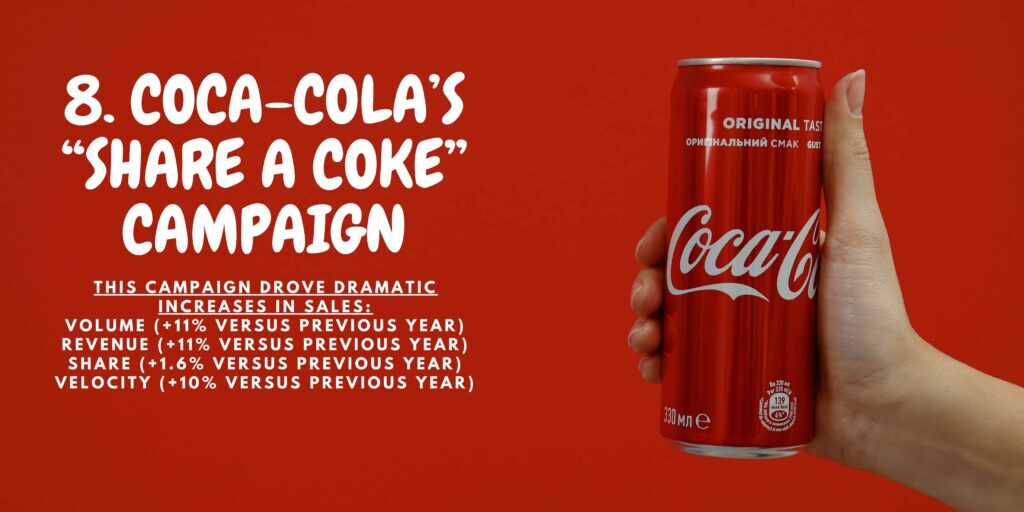
9. Nike’s “Just Do It” Campaign
Nike, a global leader in athletic footwear and apparel, aimed to reinvigorate its brand image and inspire a new generation of athletes to pursue their goals with passion and determination.
Nike’s strategy with the “Just Do It” campaign was to celebrate the spirit of determination, resilience, and perseverance embodied by athletes around the world. The campaign aimed to position Nike as a champion of athletic excellence and a catalyst for personal empowerment and achievement.
The “Just Do It” campaign was launched with a series of television commercials, print advertisements, and digital content featuring athletes from various sports and backgrounds overcoming obstacles and pushing their limits. The campaign emphasized the idea of taking action and embracing challenges with courage and determination, resonating with individuals seeking motivation and inspiration to pursue their dreams.
The “Just Do It” campaign became an iconic symbol of Nike’s brand ethos and a rallying cry for athletes and individuals striving for greatness. The campaign’s message of empowerment and perseverance resonated with consumers worldwide, driving increased brand awareness, loyalty, and sales for Nike. The “Just Do It” slogan became synonymous with Nike’s commitment to excellence and innovation, solidifying the brand’s position as a leader in the athletic industry.
What Makes it Exceptional:
Nike’s “Just Do It” campaign marketing case study is exceptional for its ability to tap into the universal human desire for achievement, empowerment, and self-expression. By celebrating the spirit of determination and resilience, the campaign inspired individuals to push their limits and pursue their goals fearlessly. The “Just Do It” slogan transcended marketing to become a cultural phenomenon, embodying Nike’s brand ethos and influencing popular culture for decades. Nike’s commitment to empowering athletes and individuals to reach their full potential has made the “Just Do It” campaign one of the most iconic and enduring advertising campaigns of all time.
This marketing initiative proved to be a pivotal moment for Nike, catapulting the company’s sales from $877 million to an impressive $9.2 billion. The campaign’s resounding success solidified Nike’s position as the premier brand in the global sportswear industry.

10. Apple’s “1984” Commercial
In 1984, Apple aimed to launch its revolutionary Macintosh computer with a groundbreaking advertisement that would challenge the status quo of the tech industry and establish Apple as a visionary brand.
Apple’s strategy with the “1984” commercial was to create a cinematic and thought-provoking advertisement that would generate buzz and intrigue surrounding the launch of the Macintosh.
The commercial aimed to position Apple as a company that defied convention and empowered individuals to think differently.
Directed by Ridley Scott, the “1984” commercial aired during the Super Bowl XVIII and depicted a dystopian future where conformity and uniformity were enforced by a Big Brother-like figure. A rebellious heroine, representing the spirit of individuality, hurled a sledgehammer at a giant screen, symbolizing the liberation brought by the Macintosh computer. The commercial concluded with the tagline, “On January 24th, Apple Computer will introduce Macintosh. And you’ll see why 1984 won’t be like ‘1984’.”
The “1984” commercial generated significant buzz and became an instant cultural phenomenon. It captured the imagination of viewers and sparked conversations about the future of technology and the power of individual expression. The commercial effectively positioned Apple as an innovative and disruptive force in the tech industry, setting the stage for the successful launch of the Macintosh computer.
What Makes it Exceptional:
Apple’s “1984” commercial marketing case study is exceptional for its boldness, creativity, and impact. By challenging the conventions of traditional advertising and delivering a powerful message of individual empowerment, the commercial captured the attention of audiences worldwide and solidified Apple’s reputation as a visionary brand.
The commercial’s cinematic quality, provocative imagery, and memorable tagline made it one of the most iconic and influential advertisements of all time, demonstrating Apple’s ability to harness the power of storytelling to connect with consumers on a deeper level.

11. Axe’s “Find Your Magic” Campaign
Axe, a leading men’s grooming brand, sought to evolve its brand image and messaging to resonate with modern consumers and challenge traditional notions of masculinity.
Axe’s strategy with the “Find Your Magic” campaign was to celebrate individuality, self-expression, and confidence, encouraging men to embrace their unique qualities and reject societal pressures to conform to traditional stereotypes of masculinity. The campaign ai
med to position Axe as a brand that empowers men to express themselves authentically and confidently.
The “Find Your Magic” campaign featured a series of advertisements and digital content showcasing a diverse range of men pursuing their passions, expressing their personalities, and defying stereotypes. The campaign celebrated moments of self-discovery, self-expression, and confidence, highlighting the idea that there is no one-size-fits-all definition of masculinity.
The campaign helped reposition Axe as a brand that celebrates diversity and empowers men to be true to themselves, driving brand loyalty and attracting new customers.
The team pointed to the 12% organic reach of the campaign as being crucial to its success.
The campaign accumulated over 39.3 million digital views and garnered four billion media impressions within the initial quarter of its launch. However, its most noteworthy impact was the initiation of a global discourse on masculinity, evident through 225,411 direct engagements with the film and over 12,000 comments across various platforms.
What Makes it Exceptional:
Axe’s “Find Your Magic” campaign marketing case study is exceptional for its bold reimagining of masculinity and its commitment to celebrating diversity and individuality. By challenging traditional stereotypes and promoting a message of inclusivity and self-confidence, Axe distinguished itself from competitors in the men’s grooming market. The campaign’s positive message resonated with consumers and helped strengthen Axe’s brand identity, positioning the brand as a champion of authenticity and self-expression.
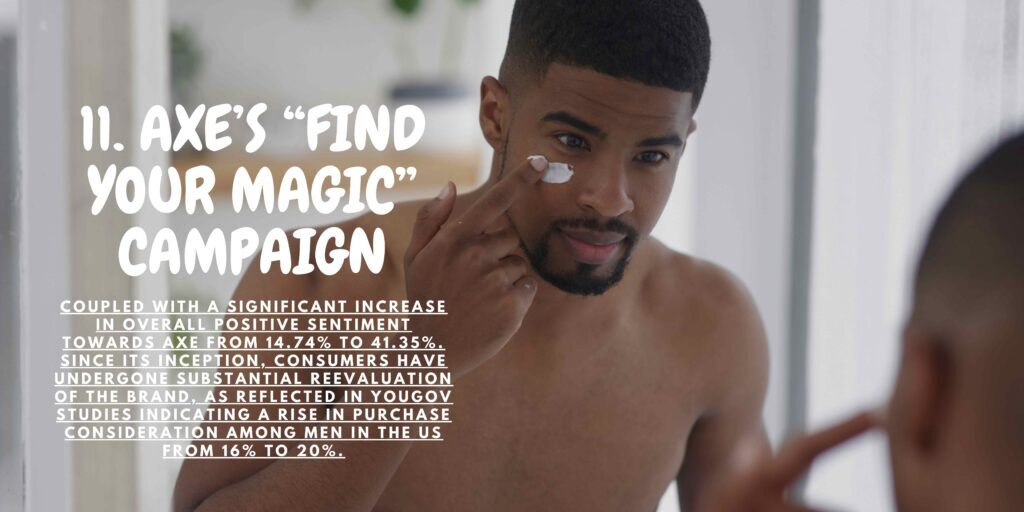
12. Burger King’s “Reclaim the Flame” Campaign
Burger King’s “Reclaim the Flame” campaign ignited a fiery spirit of rebellion against its fast-food rival, McDonald’s. Launched as a bold marketing maneuver during the 2008 Beijing Olympics, the campaign sought to reclaim the iconic flame-grilled taste that set Burger King apart from its competitors.
The campaign centered around a series of provocative advertisements that directly challenged McDonald’s by emphasizing Burger King’s commitment to flame-grilling its burgers for superior taste and quality. Through witty slogans and visually striking imagery, Burger King positioned itself as the champion of authentic, flame-grilled flavor in the fast-food industry.
The impact of the “Reclaim the Flame” campaign was palpable, as it sparked a renewed interest in Burger King’s flame-grilled offerings and reignited consumer loyalty. The campaign’s bold messaging and innovative promotions resonated with audiences, driving increased foot traffic to Burger King restaurants and boosting sales of its signature flame-grilled burgers.
What Makes it Exceptional:
Burger King’s “Reclaim the Flame” campaign marketing case study stands out for its audacious approach to marketing and its unapologetic challenge to its biggest competitor. By leveraging bold messaging and provocative promotions, Burger King effectively positioned itself as the antithesis to McDonald’s, appealing to consumers who sought a more authentic and flavorful fast-food experience.
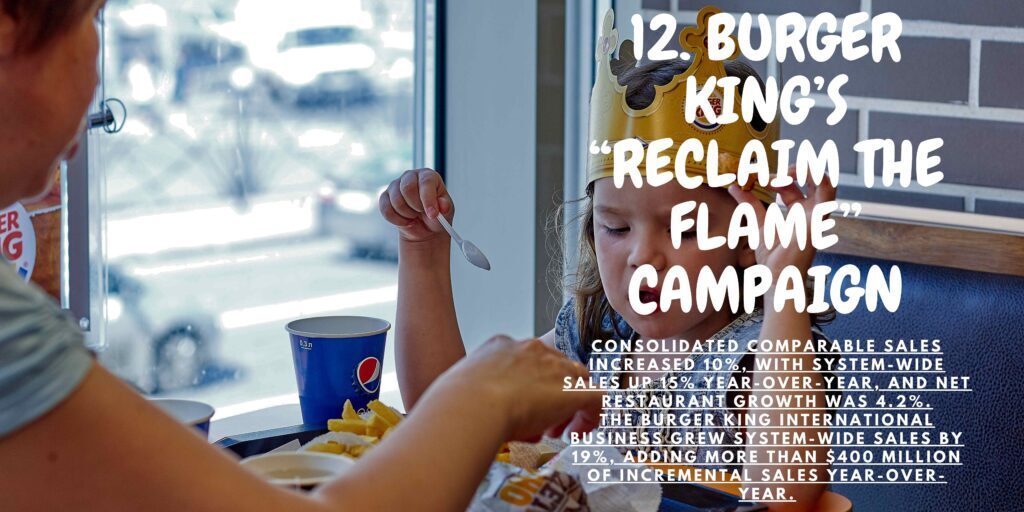
13. Guinness’s “Surfer” Advertisement
Guinness, an iconic Irish stout beer brand, aimed to reinvigorate its image and appeal to a younger demographic while staying true to its heritage and values.
Guinness launched the “Surfer” advertisement, a visually stunning and emotionally resonant commercial that showcased the brand’s commitment to quality, craftsmanship, and authenticity. The advertisement aimed to evoke a sense of awe and admiration while also conveying the message that Guinness is more than just a beer—it’s a symbol of strength, resilience, and the pursuit of excellence.
The “Surfer” advertisement featured breathtaking footage of waves crashing against a rocky coastline, interspersed with scenes of a lone surfer navigating the tumultuous waters with skill and determination. As the surfer reaches the shore and takes a sip of Guinness, the tagline “Good things come to those who wait” appears on the screen, reinforcing the brand’s message of patience, perseverance, and reward.
The commercial helped rejuvenate Guinness’s brand image and appeal to a younger audience while also resonating with existing fans of the brand. The advertisement’s message of patience and perseverance struck a chord with viewers, reinforcing Guinness’s reputation as a beer worth waiting for.
What Makes it Exceptional:
Guinness’s “Surfer” advertisement is exceptional for its ability to capture the essence of the brand’s heritage and values while also appealing to contemporary sensibilities. By celebrating the beauty of nature, the power of human determination, and the rewards of patience, the advertisement transcended traditional beer commercials and created a powerful emotional connection with viewers. The “Surfer” advertisement exemplifies Guinness’s commitment to quality, craftsmanship, and authenticity, reaffirming its status as one of the world’s most iconic beer brands.

14. McDonald’s “I’m Lovin’ It” Campaign
McDonald’s “I’m Lovin’ It” campaign epitomizes the fast-food giant’s ability to connect with consumers on a global scale through catchy slogans and memorable advertising. Launched in 2003, this campaign marked a significant shift in McDonald’s marketing strategy, aiming to evoke positive emotions and create a sense of love and affinity for the brand among customers worldwide.
At the heart of the “I’m Lovin’ It” campaign was a series of television commercials featuring upbeat music, vibrant visuals, and relatable scenarios showcasing people of all ages enjoying McDonald’s menu items. The catchy jingle, composed by music producer Pharrell Williams, became instantly recognizable and synonymous with the McDonald’s brand, further solidifying its place in popular culture.
The impact of the “I’m Lovin’ It” campaign on McDonald’s brand perception and sales was profound. The campaign helped rejuvenate McDonald’s image, positioning it as a modern and relevant brand that resonated with consumers of all ages. By emphasizing the emotional connection between customers and the brand, McDonald’s fostered loyalty and affinity among its customer base, driving increased foot traffic and sales at its restaurants worldwide.
What Makes it Exceptional:
McDonald’s “I’m Lovin’ It” campaign marketing case study stands out for its ability to create a universal and enduring brand message that transcends cultural and linguistic barriers. By tapping into the universal human desire for happiness and satisfaction, McDonald’s crafted a campaign that resonated with consumers around the world, regardless of age, background, or location.

15. Airbnb’s “Live There” Campaign
In 2016, Airbnb aimed to differentiate itself in the travel industry and emphasize its unique offering of local experiences.
Airbnb launched the “Live There” campaign, focusing on the idea that staying in an Airbnb property allows travelers to experience destinations like a local.
The campaign featured ads showcasing authentic local experiences, such as dining with locals or exploring hidden gems. It aimed to evoke a sense of belonging and immersion in the destination. The campaign resonated with travelers seeking authentic and immersive travel experiences, contributing to Airbnb’s continued growth and market leadership.
What Makes it Exceptional:
Airbnb’s “Live There” campaign marketing case study is exceptional for its focus on authentic and immersive travel experiences. By highlighting the unique aspects of staying in an Airbnb property, the campaign differentiated Airbnb from traditional accommodations and appealed to travelers seeking more meaningful connections with destinations and communities.
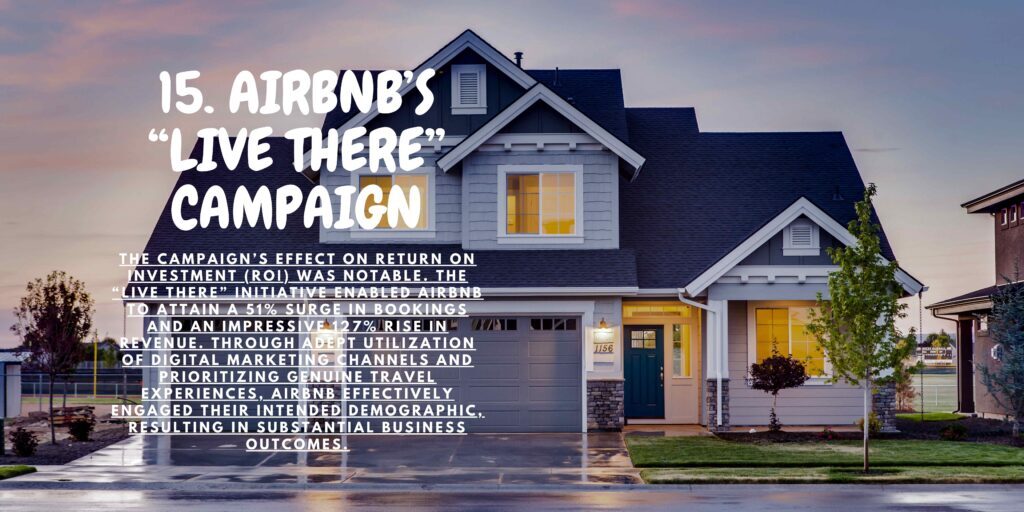
16. Lay’s “Do Us a Flavor” Campaign
Lay’s, a popular snack brand, aimed to engage consumers and drive sales by crowdsourcing new and innovative flavor ideas through its “Do Us a Flavor” campaign.
Lay’s strategy with the “Do Us a Flavor” campaign was to tap into consumer creativity and generate excitement around its brand by inviting consumers to submit their own flavor ideas. The campaign aimed to leverage user-generated content and community participation to create a sense of ownership and anticipation among consumers.
The “Do Us a Flavor” campaign encouraged consumers to submit their flavor ideas online, with the chance to win cash prizes and see their creations turned into actual Lay’s potato chip flavors. Lay’s promoted the campaign through social media, advertising, and in-store promotions, encouraging consumers to participate and vote for their favorite submissions.
The competition began in July 2012 with the unveiling of a temporary store situated in the heart of Times Square, offering visitors the opportunity to sample all 22 Lay’s flavors available in the U.S., explore flavors from around the globe, engage with celebrity spokespeople Eva Longoria and chef Michael Symon, and even catch a glimpse of what $1 million in cash looked like.
What Makes it Exceptional:
Lay’s “Do Us a Flavor” campaign marketing case study is exceptional for its innovative approach to product development and its ability to engage consumers in a fun and interactive way. By crowdsourcing flavor ideas from consumers, Lay’s not only generated excitement and buzz around its brand but also created a sense of community and collaboration among its customers.
The campaign’s success demonstrated Lay’s commitment to listening to its consumers and delivering products that resonate with their preferences and tastes.
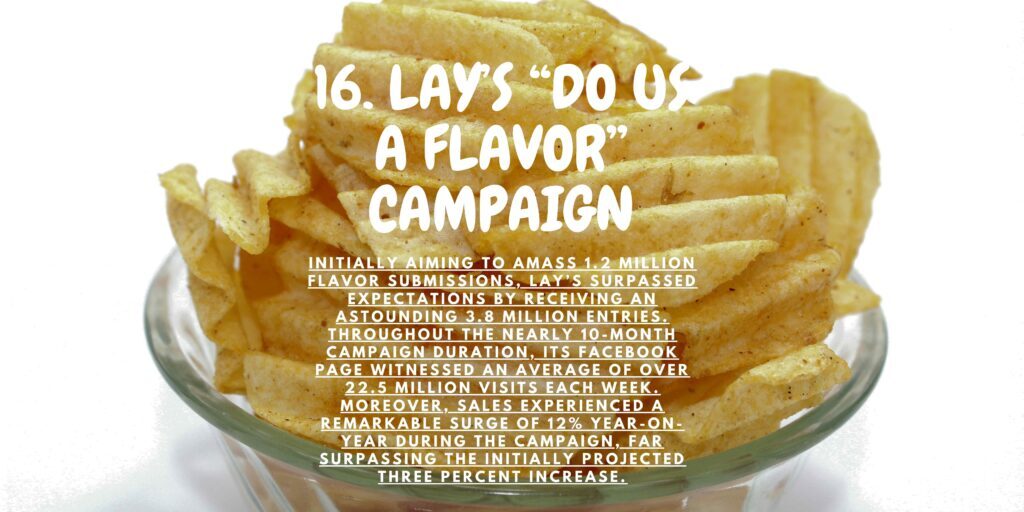
17. Amazon’s “Amazon Prime” Campaign
Amazon’s “Amazon Prime” campaign revolutionized the e-commerce industry by introducing a subscription service that offered unparalleled convenience, savings, and benefits to customers. The campaign aimed to promote Amazon Prime as more than just a shipping service, but as a comprehensive membership program that encompasses a wide range of perks and services.
At the core of the “Amazon Prime” campaign is the promise of fast, free shipping on millions of items, allowing members to enjoy expedited delivery on their purchases with no minimum order requirement. Additionally, Prime members gain access to a plethora of exclusive benefits, including streaming of movies, TV shows, and music through Prime Video and Prime Music, unlimited photo storage with Prime Photos, and early access to Lightning Deals on Amazon’s platform.
What Makes it Exceptional:
Amazon’s “Amazon Prime” campaign marketing case study stands out for its ability to redefine the e-commerce landscape and create a loyal and engaged customer base. By bundling a wide range of benefits into a single membership program, Amazon has transformed the way people shop online, making Prime membership synonymous with convenience, value, and innovation.
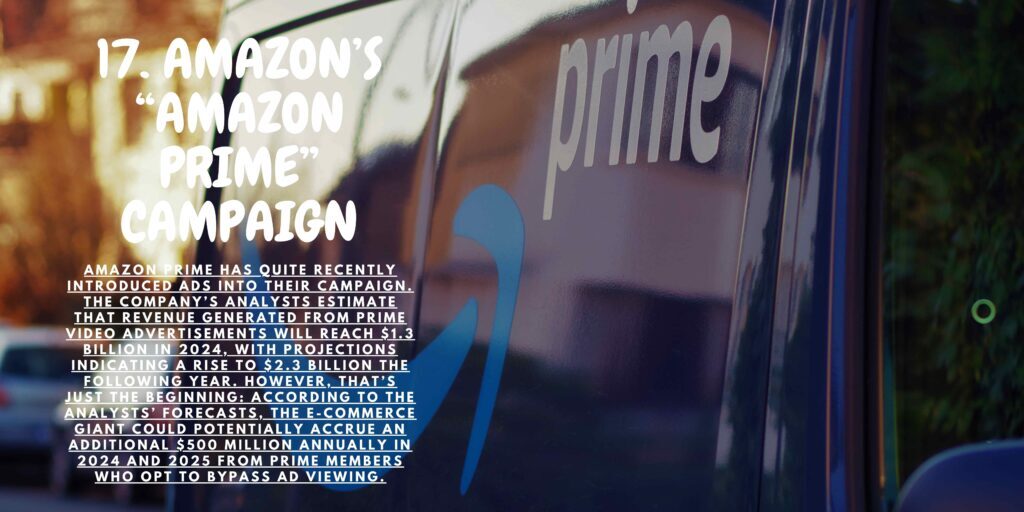
18. GoPro’s “Be a Hero” Campaign
GoPro’s “Be a Hero” campaign embodies the adventurous spirit and passion for storytelling that defines the brand’s identity. The campaign encourages users to capture and share their most epic moments using GoPro cameras, empowering them to become heroes of their own stories.
At the core of the “Be a Hero” campaign is GoPro’s belief that everyone has the potential to live a life worth recording.
The campaign leverages social media platforms, such as Instagram and YouTube, to showcase the incredible footage captured by GoPro users in various extreme sports, outdoor adventures, and everyday moments. By highlighting the versatility and durability of its cameras, GoPro positions itself as the ultimate tool for capturing life’s most exhilarating experiences.
The impact of the “Be a Hero” campaign on GoPro’s brand perception and sales has been significant. By encouraging users to become content creators and ambassadors for the brand, GoPro has cultivated a loyal fan base and differentiated itself from competitors in the action camera market. The campaign has also helped GoPro maintain its position as a leader in the industry and drive continued growth and innovation.
This campaign was a huge success nearly doubling its revenue throughout the following years; from $234.2 million in 2011 to $526 million in 2012 and $985.7 million in 2013.
What Makes it Exceptional:
GoPro’s “Be a Hero” campaign marketing case study stands out for its ability to tap into the aspirational desires of its target audience and inspire them to live life to the fullest. By empowering users to capture and share their most epic moments, GoPro has created a powerful brand narrative that resonates with adventurers, athletes, and storytellers around the world.
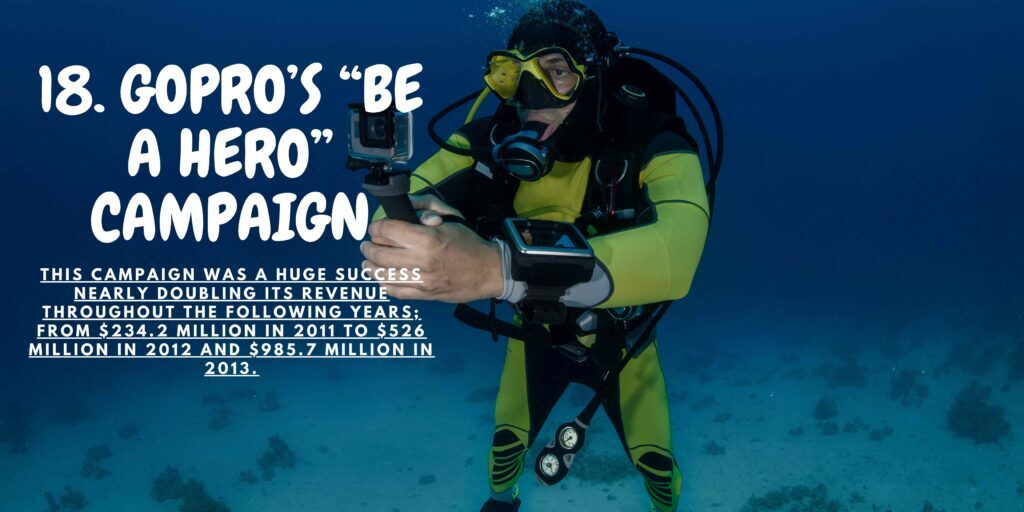
19. Volvo Trucks’ “The Epic Split” Campaign
Volvo Trucks’ “The Epic Split” campaign featuring Jean-Claude Van Damme is one of the most iconic and memorable marketing stunts in recent history. The campaign aimed to showcase the precision and stability of Volvo Trucks’ dynamic steering system through a jaw-dropping demonstration performed by the legendary action star, Jean-Claude Van Damme.
At the heart of the campaign is a mesmerizing video that captures Van Damme performing an incredible split between two moving Volvo Trucks. Set to the haunting melody of Enya’s “Only Time,” the video showcases Van Damme’s unparalleled agility and balance as he maintains a perfect split position while suspended between the two trucks as they reverse along a deserted runway.
The video quickly went viral, garnering millions of views within days of its release and sparking widespread admiration and discussion among viewers worldwide.
In addition to the viral video, the campaign was supported by a comprehensive digital and social media strategy that amplified its reach and impact. Through strategic partnerships with influencers and media outlets, Volvo Trucks ensured that “The Epic Split” reached a wide audience and generated maximum buzz and engagement.
This video was part of Volvo Trucks’ Live Test film, which between June 2012 and May 2014 generated 100m+ YouTube views and were shared nearly 8 million times.
What Makes it Exceptional:
Volvo Trucks’ “The Epic Split” campaign marketing case study stands out for its sheer audacity and creativity. By enlisting Jean-Claude Van Damme to perform an awe-inspiring stunt that perfectly showcased the capabilities of its trucks, Volvo Trucks created a marketing masterpiece that captured the imagination of millions.

20. Dove’s “Real Beauty Sketches” Campaign
Dove aimed to challenge beauty stereotypes and promote self-esteem among women.
Dove launched the “Real Beauty Sketches” campaign, featuring an FBI-trained sketch artist creating composite sketches of women based on their own descriptions and those of strangers.
The campaign’s video highlighted the stark difference between how women perceive themselves and how others see them, emphasizing the negative impact of self-criticism on self-esteem. It went viral, sparking conversations about beauty standards and generating widespread media coverage.
As a result of the Real Beauty campaign, sales for Dove jumped from $2.5 to $4 billion in the campaign’s first ten years. The corporation boosted its revenues by 10% within a year. Nearly two decades later, the promotional endeavor continues to be active, with intentions to extend its reach into the digital realm.
What Makes it Exceptional:
Dove’s “Real Beauty Sketches” campaign is exceptional for its emotional resonance and societal impact. By shedding light on the issue of self-esteem and body image, Dove struck a chord with audiences and sparked a global conversation about beauty, confidence, and self-acceptance.
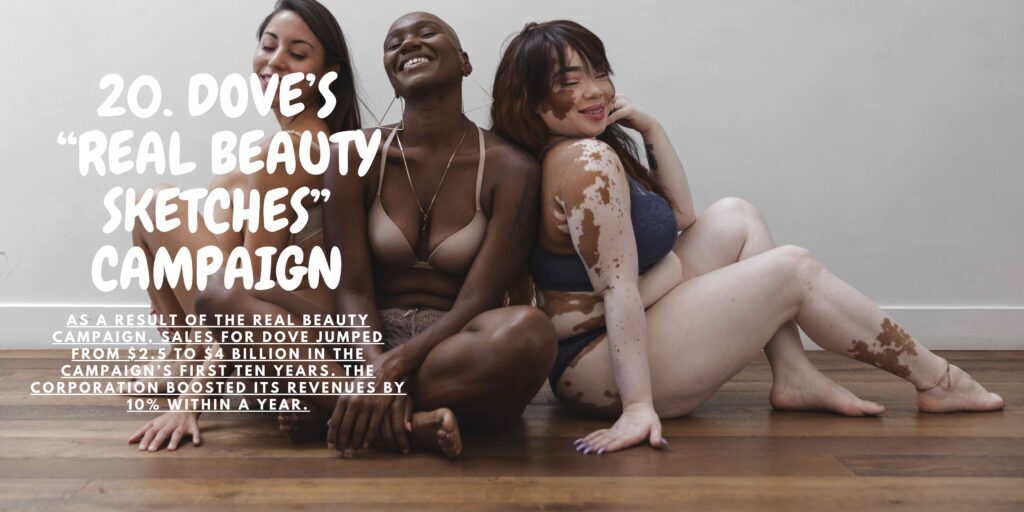
21. Spotify’s “Wrapped” Campaign
Spotify’s “Wrapped” campaign has become an annual phenomenon that celebrates the unique music tastes and listening habits of its users. The campaign offers personalized insights and highlights into each user’s year of listening on the platform, including their most-streamed songs, artists, and genres.
At the core of the “Wrapped” campaign is the idea of music as a deeply personal and emotive experience. By curating and presenting users with a personalized summary of their year in music, Spotify aims to foster a sense of connection and nostalgia while also showcasing the diversity and richness of its music library.
The campaign unfolds across various touchpoints, including the Spotify app, social media platforms, and digital advertisements. Users are encouraged to share their “Wrapped” summaries with friends and followers, sparking conversations and debates about music preferences and discoveries.
One of the key strengths of the “Wrapped” campaign is its ability to tap into the power of data and personalization.
What Makes it Exceptional:
Spotify’s “Wrapped” campaign marketing case study stands out for its ability to transform data into meaningful and emotional experiences for users. By curating personalized summaries that celebrate the diversity and individuality of each user’s music tastes, Spotify creates a sense of connection and belonging that resonates deeply with its audience.

22. Iceland Groceries Campaign
Iceland, a UK-based supermarket chain, embarked on a groundbreaking marketing campaign to challenge misconceptions and revolutionize perceptions surrounding frozen food. The campaign aimed to redefine the narrative around frozen groceries by highlighting their quality, convenience, and sustainability.
At the heart of the Iceland Groceries campaign is a commitment to transparency and authenticity. By showcasing the sourcing and production processes behind its frozen food offerings, Iceland sought to reassure consumers about the freshness and nutritional value of its products.
One of the key strengths of the Iceland Groceries campaign is its focus on education and empowerment. By providing consumers with information about the benefits of frozen food and debunking common myths, Iceland empowers them to make informed choices and embrace frozen groceries as a convenient and sustainable option.
What Makes it Exceptional:
The Iceland Groceries campaign marketing case study stands out for its boldness and innovation in challenging industry norms and stereotypes. By tackling misconceptions head-on and championing the benefits of frozen food, Iceland has sparked meaningful conversations and changed perceptions among consumers.
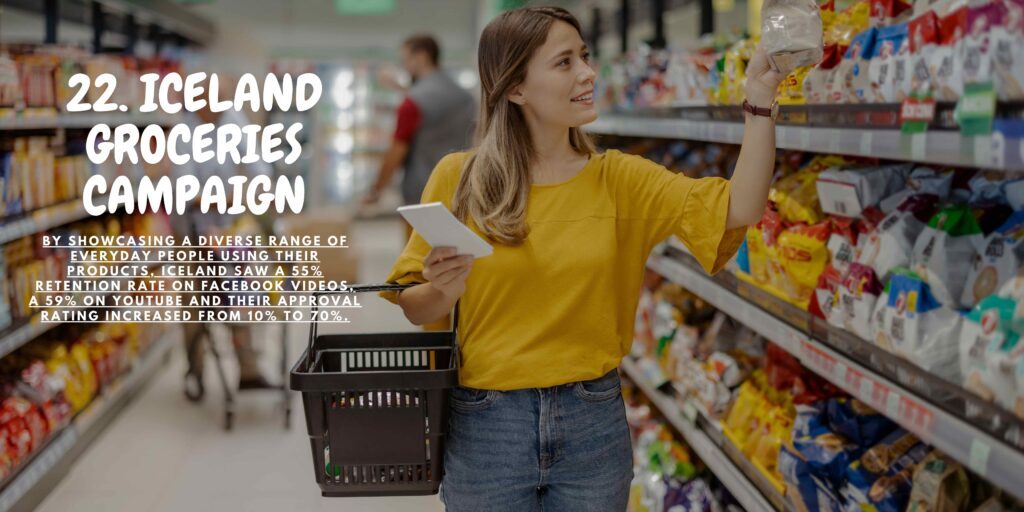
23. Health-Ade’s Marketing Campaign
Health-Ade, a leading kombucha brand in the United States, embarked on an innovative marketing campaign to promote its products and differentiate itself in the competitive beverage market. The campaign aimed to position Health-Ade as a premium and health-conscious choice for consumers seeking natural and nutritious beverages.
At the core of the Health-Ade marketing campaign is a commitment to authenticity and quality. Unlike many mass-produced beverages, Health-Ade kombucha is handcrafted in small batches using only the highest quality ingredients, including organic tea and natural flavors. The campaign highlights Health-Ade’s dedication to traditional brewing methods and its unwavering commitment to producing the best-tasting and most nourishing kombucha on the market.
Through vibrant imagery, engaging storytelling, and compelling messaging, Health-Ade showcases the unique flavor profiles and health benefits of its kombucha, inviting consumers to join the “Health-Ade family” and embrace a healthier lifestyle.
What Makes it Exceptional:
The Health-Ade marketing campaign marketing case study stands out for its authenticity, quality, and commitment to promoting health and wellness. By prioritizing transparency and education, Health-Ade has earned the trust and loyalty of consumers, distinguishing itself from competitors and driving strong sales growth.
Moreover, the campaign’s focus on creating a sense of community and belonging has been instrumental in building brand affinity and advocacy. Through engaging storytelling and experiential activations, Health-Ade has fostered connections with consumers and established itself as not just a beverage brand, but a lifestyle choice.
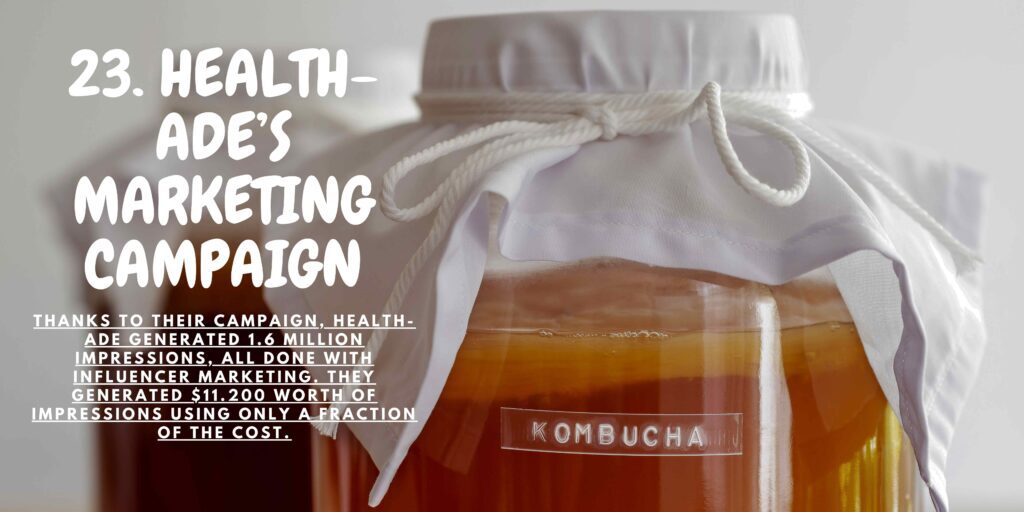
24. Always’ “Like a Girl” Campaign
Always sought to challenge societal perceptions of what it means to do something “like a girl” and empower girls and women.
Always launched the “Like a Girl” campaign, featuring a video highlighting the negative connotations associated with the phrase “like a girl” and showcasing the confidence and strength of young girls.
The video aimed to change the meaning of “like a girl” to represent strength, confidence, and capability. It sparked a global conversation about gender stereotypes and garnered widespread praise for its empowering message. Always continued the campaign with initiatives to support girls’ confidence and self-esteem.
The results of Always #LikeAGirl campaign led to 4.4bn+ media impressions and 177,000 #LikeAGirl tweets in the first three months. After the campaign, 50% of women chose to purchase Always brand over competitors.
What Makes it Exceptional:
Always‘ “Like a Girl” campaign marketing case study is exceptional for its impact on cultural perceptions and empowerment. By challenging ingrained stereotypes and celebrating the strength and potential of girls, Always inspired positive change and fostered a more inclusive and supportive environment for girls and women worldwide.

25. Coca-Cola’s “Small World Machines”
Coca-Cola aimed to foster connections between people from India and Pakistan, two neighboring countries with a history of tension.
Coca-Cola created “Small World Machines,” special vending machines placed in public areas in India and Pakistan, allowing people from both countries to interact with each other via live video feeds.
Participants could see and interact with each other in real-time, completing tasks together and sharing moments of joy. The initiative aimed to break down barriers and promote peace and understanding between the two nations.
What Makes it Exceptional:
Coca-Cola’s “Small World Machines” campaign marketing case study is exceptional for its efforts to bridge divides and promote unity through technology and shared experiences. By facilitating interactions between individuals from countries with historical tensions, Coca-Cola demonstrated the power of human connection and the potential for brands to promote social good and understanding on a global scale.
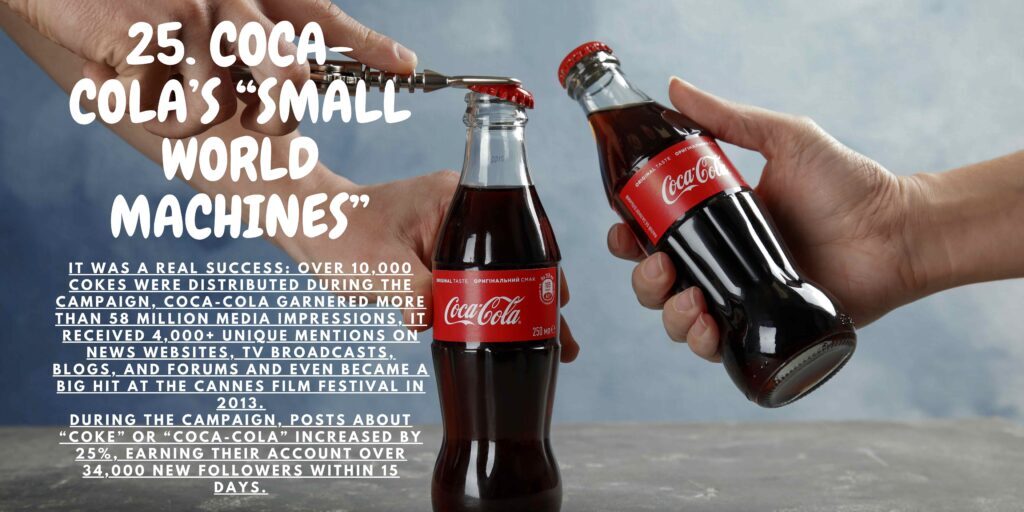
26. Burger King’s “Whopper Detour” Campaign
Burger King, a global fast-food chain, aimed to increase customer engagement and drive traffic to its restaurants through an innovative marketing campaign.
Burger King launched the “Whopper Detour” campaign, which leveraged geolocation technology to offer customers a steep discount on its signature burger, the Whopper, but with a catch: they could only claim the deal by ordering through the Burger King app while physically inside or near a McDonald’s restaurant.
Using geofencing technology, Burger King targeted customers who were within 600 feet of a McDonald’s restaurant. When these customers opened the Burger King app, they were prompted to “unlock” the Whopper deal by navigating to the nearest Burger King location. The campaign generated buzz and curiosity among consumers, driving them to download the Burger King app and visit Burger King restaurants to claim their discounted Whoppers.
The “Whopper Detour” campaign was a success, generating millions of app downloads and significantly increasing foot traffic to Burger King restaurants.
What Makes it Exceptional:
Burger King’s “Whopper Detour” campaign marketing case study is exceptional for its creativity, innovation, and effectiveness in driving customer engagement and foot traffic to its restaurants. By leveraging geolocation technology and gamifying the customer experience, Burger King created a memorable and engaging campaign that resonated with consumers and generated excitement around its brand.
The campaign’s success demonstrates Burger King’s willingness to push the boundaries of traditional marketing and its ability to connect with consumers in new and unexpected ways.

27. Amazon’s Prime Day
Amazon sought to drive sales and boost Prime membership subscriptions during typically slower shopping periods. Amazon launched Prime Day, a one-day shopping event exclusive to Prime members, offering discounts on a wide range of products.
Prime Day featured limited-time deals, flash sales, and exclusive product launches, creating a sense of urgency and excitement among shoppers. The event generated record-breaking sales, surpassing even Black Friday and Cyber Monday numbers. Additionally, Prime membership sign-ups increased significantly during Prime Day.
What Makes it Exceptional:
Amazon’s Prime Day marketing case study is exceptional for its ability to create a shopping frenzy and drive sales while also incentivizing Prime membership subscriptions. By offering exclusive deals and benefits to Prime members, Amazon not only boosted revenue but also strengthened customer loyalty and engagement, solidifying Prime as a must-have subscription service for millions of shoppers.
The campaign’s success demonstrates Burger King’s willingness to push the boundaries of traditional marketing and its ability to connect with consumers in new and unexpected ways.

28. McDonald’s “Our Food, Your Questions” Campaign
McDonald’s aimed to address misconceptions and concerns about the quality and sourcing of its food ingredients.
They launched the “Our Food, Your Questions” campaign, inviting customers to ask any questions they had about McDonald’s food via social media and other channels.
McDonald’s responded transparently to customer inquiries, providing detailed information about its food sourcing, preparation methods, and quality standards. The campaign helped demystify McDonald’s food and build trust with customers by demonstrating the company’s commitment to transparency and quality.
What Makes it Exceptional:
McDonald’s “Our Food, Your Questions” campaign marketing case study is exceptional for its transparency and engagement with customers. By openly addressing concerns and providing clear information about its food, McDonald’s strengthened its relationship with consumers and demonstrated a willingness to listen and respond to their feedback.

29. Airbnb’s “Experiences” Launch
Airbnb aimed to expand its offerings beyond accommodations and provide travelers with unique, immersive experiences.
Airbnb launched “Experiences,” a platform where hosts could offer activities, tours, and workshops to travelers, allowing them to engage with local culture and communities.
They curated a diverse range of experiences, from cooking classes to outdoor adventures, and promoted them to travelers worldwide. The platform quickly gained popularity, attracting both hosts and guests seeking authentic and personalized travel experiences.
What Makes it Exceptional:
Airbnb’s “Experiences” launch is exceptional for its innovation and ability to tap into the growing demand for experiential travel. By leveraging its existing platform and network of hosts, Airbnb expanded its offerings to include activities and experiences, further enhancing its value proposition and solidifying its position as a leader in the travel industry.

30. Pizza Hut’s “Hut Rewards” Loyalty Program
Pizza Hut, a leading pizza restaurant chain, aimed to increase customer retention and drive repeat business in a competitive market.
Pizza Hut’s strategy with the “Hut Rewards” loyalty program was to incentivize customers to return to their restaurants by offering rewards and discounts for frequent purchases. The program aimed to build customer loyalty and increase customer lifetime value by rewarding customers for their continued patronage.
The “Hut Rewards” loyalty program allowed customers to earn points for every dollar spent on Pizza Hut purchases, including online orders, delivery, and dine-in. Customers could redeem their points for free pizzas, sides, and other menu items, providing an incentive for repeat visits.
The loyalty program proved to be successful in driving customer engagement and loyalty for Pizza Hut. It attracted new customers and encouraged existing customers to increase their frequency of visits and spending.
Pizza Hut saw an increase in customer retention and repeat business, leading to higher sales and revenue for the company.
What Makes it Exceptional:
Pizza Hut’s “Hut Rewards” loyalty program marketing case study is exceptional for its ability to effectively incentivize customer loyalty and drive repeat business. By offering tangible rewards for frequent purchases, Pizza Hut created a strong incentive for customers to choose Pizza Hut over competitors and return to their restaurants regularly.
The program’s simplicity and accessibility made it easy for customers to participate, further enhancing its effectiveness in building brand loyalty and increasing customer lifetime value.
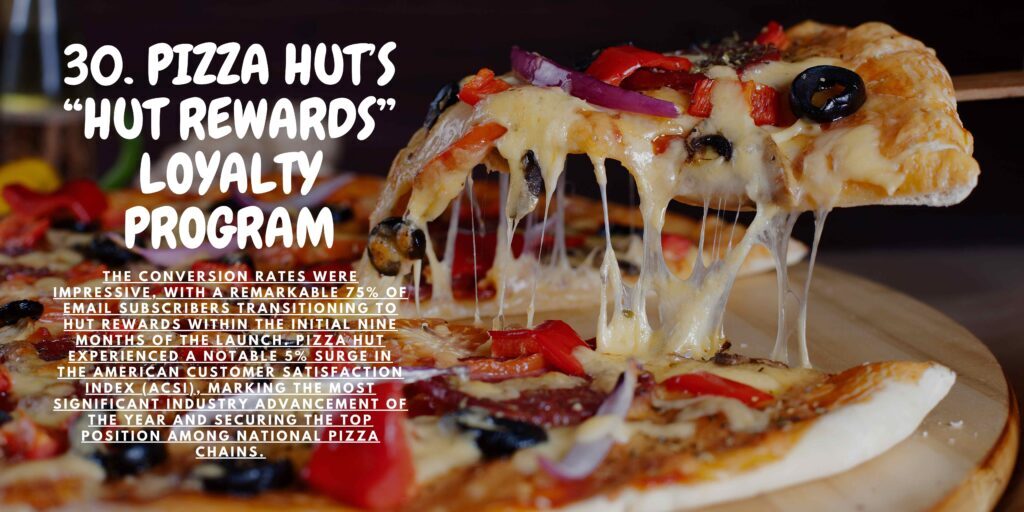
31. BMW’s “The Ultimate Driving Machine” Campaign
BMW’s “Ultimate Driving Machine” campaign, introduced in the early 1970s, remains one of the most iconic and enduring advertising campaigns in the automotive industry. The campaign aimed to redefine the perception of BMW automobiles by emphasizing the brand’s commitment to delivering unparalleled performance, precision engineering, and driving pleasure.
Through a series of television commercials, print advertisements, and digital content, BMW positioned itself as the premier choice for drivers who demanded more than just transportation – they sought an exhilarating driving experience unlike any other.
The campaign leveraged innovative storytelling techniques and striking visuals to showcase BMW’s vehicles in action, highlighting their agility, responsiveness, and dynamic performance on the road.
What Makes it Exceptional:
BMW’s “Ultimate Driving Machine” campaign marketing case study is exceptional for its longevity, consistency, and effectiveness in communicating the brand’s core values and identity. By focusing on the driving experience and performance capabilities of its vehicles, BMW differentiated itself from competitors and established a unique position in the automotive market.
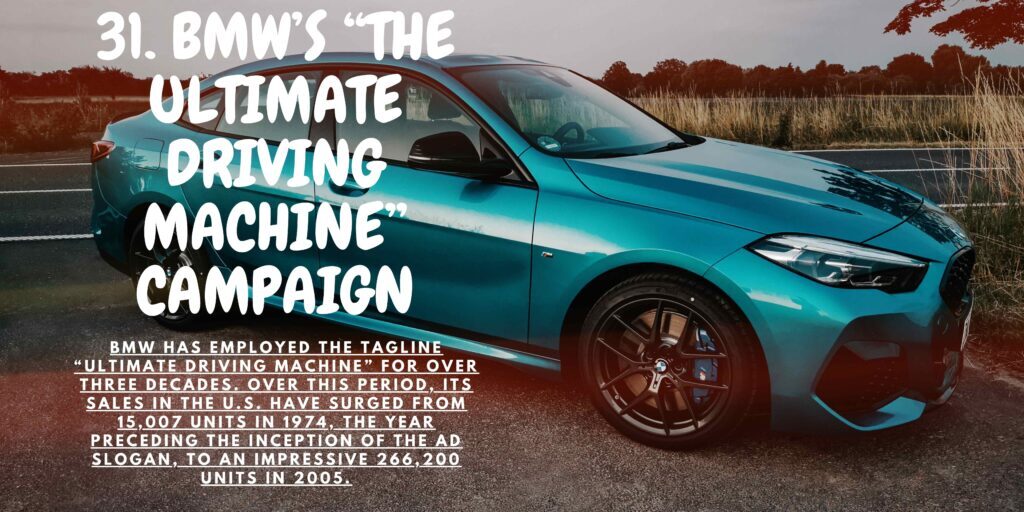
32. “The Most Interesting Man in the World” Campaign
Dos Equis launched its iconic “The Most Interesting Man in the World” campaign to redefine the beer industry’s advertising landscape. The campaign aimed to position Dos Equis as the beer of choice for discerning and adventurous consumers seeking sophistication and worldly experiences.
The campaign was about the enigmatic and charismatic character of “The Most Interesting Man in the World.” Portrayed by actor Jonathan Goldsmith, this suave and debonair figure embodied the epitome of sophistication, charm, and adventure. Through a series of memorable television commercials, print advertisements, and digital content, Dos Equis brought the character to life, regaling viewers with tales of his extraordinary exploits and remarkable accomplishments.
The campaign’s success was built on the strength of its storytelling and the allure of its central character. With his distinctive catchphrase, “I don’t always drink beer, but when I do, I prefer Dos Equis,” “The Most Interesting Man in the World” captured the imagination of audiences worldwide, becoming a cultural phenomenon in the process.
What Makes it Exceptional:
Dos Equis’ “The Most Interesting Man in the World” campaign marketing case study stands out for its boldness, creativity, and enduring appeal. By creating a compelling character and narrative that transcended traditional beer advertising, Dos Equis captured the hearts and minds of consumers, elevating its brand to iconic status.
The campaign’s success was driven by its ability to tap into universal themes of adventure, intrigue, and sophistication. By positioning Dos Equis as the beer of choice for those who embrace life’s extraordinary moments, the campaign resonated with consumers across demographics.
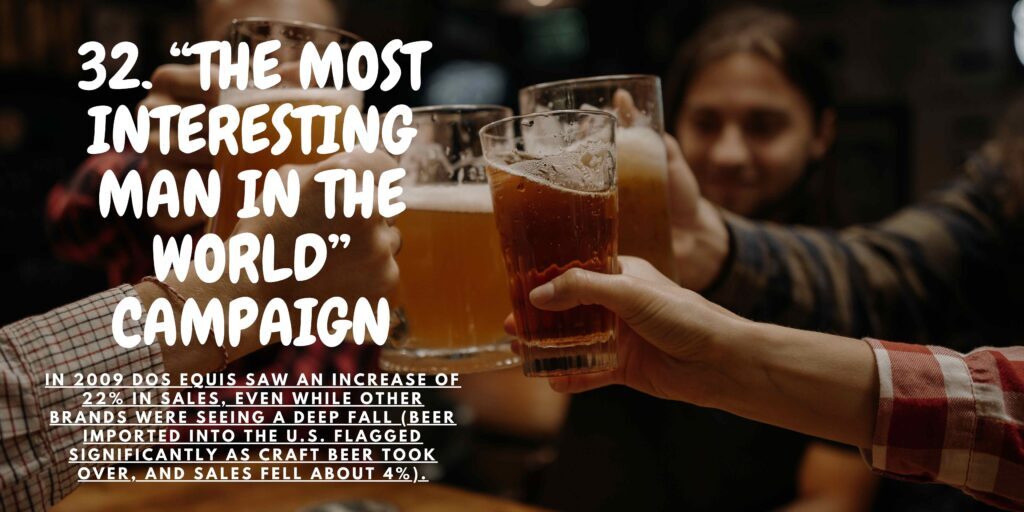
33. Apple’s “Get a Mac” Campaign
Apple’s “Get a Mac” campaign was a series of television commercials that aimed to highlight the superiority of Mac computers over PCs in a humorous and relatable manner. The campaign featured two characters: a young, casually dressed man representing a Mac computer (played by actor Justin Long) and an older, more formal man representing a PC (played by actor John Hodgman).
Each commercial followed a similar format, with the two characters engaging in witty banter as they discussed various aspects of computer usage and functionality. The Mac character would typically showcase the ease of use, reliability, and innovative features of Mac computers, while the PC character would struggle with technical issues, viruses, and compatibility problems.
The brilliance of the “Get a Mac” campaign lay in its simplicity and effectiveness. By personifying the two types of computers and highlighting the differences between them in a lighthearted and entertaining manner, Apple effectively communicated the benefits of choosing a Mac over a PC to consumers.
What Makes it Exceptional:
Apple’s “Get a Mac” campaign marketing case study is exceptional for its ability to effectively communicate complex technical concepts in a simple and engaging manner. By using humor and relatable characters, Apple made the benefits of Mac computers accessible to a wide audience, driving increased interest and adoption of its products.
Moreover, the campaign’s emphasis on user experience and innovation resonated with consumers who were increasingly seeking technology solutions that were intuitive, reliable, and stylish. By positioning Mac computers as the superior choice for creative professionals, students, and everyday users alike, Apple successfully differentiated itself from competitors and established a loyal customer base.

34. Procter & Gamble’s “Thank You, Mom” Campaign
Procter & Gamble’s “Thank You, Mom” campaign was a heartwarming and emotionally resonant tribute to the mothers of Olympic athletes. The campaign aimed to celebrate the unwavering support and sacrifices made by mothers in nurturing their children’s dreams and aspirations, particularly as they pursued excellence in sports on the global stage.
The centerpiece of the campaign was a series of television commercials and digital content that showcased the intimate and poignant moments between Olympic athletes and their mothers. These emotionally charged vignettes depicted the mothers’ role as pillars of strength, encouragement, and inspiration throughout their children’s athletic journeys, from their earliest beginnings to the pinnacle of their success on the Olympic stage.
By highlighting the profound bond between mothers and their children, the “Thank You, Mom” campaign struck a chord with audiences worldwide, eliciting a range of emotions from nostalgia and admiration to gratitude and reverence. It served as a powerful reminder of the pivotal role that mothers play in shaping their children’s lives and fostering their dreams, both on and off the field of competition.
Thank You, Mom was the biggest and most successful global campaign in P&G’s 175-year history with $500 million in global incremental P&G sales, 76 billion global media impressions, and over 74,000,000 global views.
What Makes it Exceptional:
Procter & Gamble’s “Thank You, Mom” campaign marketing case study is exceptional for its emotional resonance and universal appeal. By celebrating the selfless love and sacrifice of mothers, the campaign struck a chord with audiences of all ages and backgrounds, fostering a deep and lasting connection with the brand.
Moreover, the campaign’s alignment with the Olympic Games provided a powerful platform to amplify its message of gratitude and appreciation on a global scale. Through its partnership with the world’s premier sporting event, Procter & Gamble was able to reach audiences around the world and inspire millions with its heartfelt tribute to mothers.
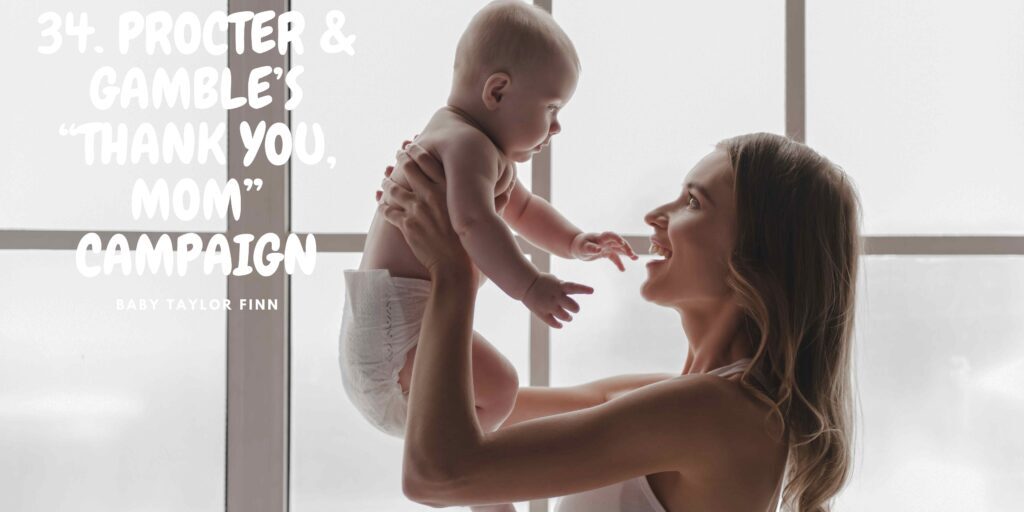
35. Metro Trains – Dumb Ways to Die
Metro Trains’ “Dumb Ways to Die” campaign was a groundbreaking and innovative public safety initiative aimed at promoting railway safety in Melbourne, Australia. The campaign sought to raise awareness about the dangers of reckless behavior around trains and railway tracks in a creative and engaging manner.
At the heart of the campaign was a catchy song and colorful animation featuring a cast of quirky characters engaging in various foolish and dangerous activities, such as standing too close to the edge of the platform or playing on railway tracks. The song’s upbeat melody and humorous lyrics served to captivate audiences of all ages, while delivering a serious message about the potential consequences of risky behavior near trains.
In addition to the animated video, the “Dumb Ways to Die” campaign was accompanied by a range of educational materials and interactive experiences, including posters, social media content, and mobile games. These elements helped to reinforce the campaign’s safety message and encourage audiences to take positive actions to prevent accidents and injuries on and around railway tracks.
Thanks to this campaign, , Metro Trains found around a 20% reduction in train station incidents.
Within 24 hours of launch, the Dumb Ways to Die song was ranked in the iTunes top 10. In just 48 hours it became number 6 in the singer/songwriter category globally. Many covers were produced by different artists and the song was used in school as an effective method for teaching safety.
What Makes it Exceptional:
Metro Trains’ “Dumb Ways to Die” campaign marketing case study is exceptional for its ability to tackle a serious and important issue with creativity, humor, and humanity. By using animation, music, and storytelling to deliver its safety message, the campaign transcended traditional public service announcements and connected with audiences on a deeper level.

The Future of Marketing Case Studies
The exploration of these 35 top marketing case studies unveils a diverse array of strategies, executions, and exceptional results achieved by brands across various industries. From innovative product launches to impactful social campaigns, each case study exemplifies the power of creativity, strategic thinking, and consumer-centric approaches in driving success.
What stands out in these case studies is the emphasis on authenticity, engagement, and addressing consumer needs and aspirations. Brands that dared to be bold, transparent, and empathetic resonated deeply with their audiences, fostering lasting connections and loyalty.
Moreover, these case studies underscore the importance of adaptability and innovation in navigating rapidly evolving market landscapes. Brands that embraced change, leveraged emerging technologies, and responded effectively to shifting consumer behaviors emerged as leaders in their respective industries.
Ultimately, the success of these marketing case studies lies in their ability to capture hearts, minds, and market share through compelling storytelling, genuine human connections, and a relentless pursuit of excellence.
As brands continue to navigate the ever-changing marketing landscape, these case studies serve as valuable lessons and inspiration for creating impactful campaigns that stand the test of time and leave a lasting impression on consumers.


